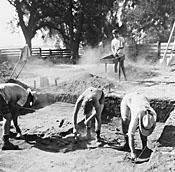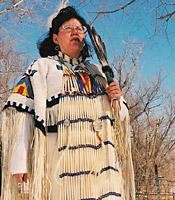Celebrate Indigenous Peoples’ Day
"In 1977 participants at the United Nations International Conference on Discrimination against Indigenous Populations in the Americas proposed that Indigenous Peoples’ Day replace Columbus Day. Indigenous Peoples’ Day recognizes that Native people are the first inhabitants of the Americas, including the lands that later became the United States of America. And it urges Americans to rethink history." (Sourced from Indigenous Peoples’ Day: Rethinking How We Celebrate American History, Dennis W. Zotigh and Renee Gokey, 2019, National Museum of the American Indian.)
Why Do We Celebrate Indigenous Peoples Day?
Indigenous Peoples Day is a day to acknowledge these hard truths, the broken treaties, and the forced removal of Indigenous people at the hands of the U.S. government and its citizens who stole land that was not theirs to take. It is also vital that we recognize the original stewards of the land we now occupy and where they are now as a result. This is part of a step towards healing and reconciliation with Native communities.
- American Indian Digital History Project ". . .a Digital History Cooperative founded to recover and preserve rare Indigenous newspapers, photographs, and archival materials from all across Native North America."
- “Decolonial” Reading List Analú López (Indigenous curator at The Newberry Library), 2020 "I have been asked for book and article recommendations over the years for “decolonizing the archives, decolonizing education, decolonizing spaces,” etc. ... I approach this method through what some may call a “Decolonial lens” but what I refer to as a “enhancing representation” praxis, that is, being inclusive of varying perspectives from marginalized communities (particularly Black/Indigenous/People of Color/Queer/Trans) while also bringing these voices to the front."
- The Red Nation "The Red Nation is dedicated to the liberation of Native peoples from capitalism and colonialism. We center Native political agendas and struggles through direct action, advocacy, mobilization, and education."
- Rethinking "Thanksgiving" Toolkit Indigenous Solidarity Network INDIGENOUS SOLIDARITY NETWORK "The Indigenous Solidarity Network has developed this toolkit geared for white folks to discuss settler privilege and Thanksgiving with family, friends, and broader community. ... We need to talk about the history and ongoing reality of settler colonialism. (Meaning how European people violently took over lands and peoples for their own gains, and came to stay. In the US, this process of settling included enslaving people of African descent to build a country on Indigenous land.)" (p. 2)
- Dawes Act and Commission (Library of Congress Research Guide) The Dawes Act established land allotment to Native Americans, but it was overcome with conflict. This guide provides access to materials related to the “Dawes Act and Commission” in the Chronicling America digital collection of historical newspapers.
- Ghost Dance Movement (Library of Congress Research Guide) In the 1890s, growth of the Ghost Dance Movement led to fear, conflict, and fascination. This guide provides access to materials related to the “Ghost Dance Movement” in the Chronicling America digital collection of historic newspapers.
- Native American Education (Library of Congress Research Guide) Assimilation of Native American culture through "Indian Schools" led to controversy and backlash. This guide provides access to materials related to "Native American Education" in the Chronicling America digital collection of historic newspapers.
- Wounded Knee Massacre (Library of Congress Research Guide) In 1890, anxiety about the Ghost Dance prompts US Army troops to shoot Native Americans at Wounded Knee. This guide provides access to material related to the "Wounded Knee Massacre" in the Chronicling America digital collection of historic newspapers.
Local Resources
- American Indian Center Chicago The American Indian Center of Chicago (AIC) has a long history of serving American Indians. Established in 1953, this Center is the first urban Indian Center in the country.
- Midwest SOARRING (Save Our Ancestors Remains & Resources Indigenous Network Group) Midwest SOARRING (Save Our Ancestors Remains & Resources Indigenous Network Group) Foundation was formed in November of 1996. Our mission is to offer assistance, when asked, as a facilitator to the tribes regarding repatriation concerns, educate the public about various American Indian cultural issues, environmental issues, and build community among all people.
- The Chicago American Indian Community Collaborative The members of the Chicago American Indian Community Collaborative are dedicated to furthering diverse causes and the greater well-being of American Indians, Alaska Natives, Native Hawaiians and First Nations people in the Chicago area. We seek to maximize effectiveness by creating a forum for fostering mutual aide, political support, positive public recognition, strategic alliances, collaborations, and partnerships. CAICC will convene organizational leaders and members of the Chicago American Indian community for dialogue, advocacy and planning with the goal of empowering CAICC to better address the issues and needs of the American Indian community.
- Mitchell Museum of the American Indian The Mitchell Museum of the American Indian is one of only a handful of museums across the country that focuses exclusively on the art, history, and culture of Native American and First Nation peoples from throughout the United States and Canada. It promotes public understanding of cultural diversity through first voice perspectives.
- Chicago Title VI American Indian Education Program The Title VI American Indian Education Formula Grant Program offers services to Chicago Public School’s American Indian families, educators, and community members. The staff acts as a liaison between CPS and American Indian families to provide extracurricular activities, after-school programming, culturally oriented community events, and options for higher education/selective enrollment within the school district. Working closely with district curriculum writers, we are able to contemporize American Indians by providing resources such as books, documentaries, activity guides, etc. to the public schools, which in turn benefits the overall image of American Indians and AI students.
- American Indian Association of Illinois The American Indian Association of Illinois provides expert educational programs, extensive academic/social support and financial planning for students and families to access and be successful. For American Indian people, AIAI programs provide a culturally based foundation of education grounded in tribal knowledge.
- D’Arcy McNickle Center for American Indian and Indigenous Studies: Newberry Library The D’Arcy McNickle Center for American Indian and Indigenous Studies was founded in 1972. Its goals are to encourage the use of the Newberry collections in these areas of study; improve the quality of what is written about American Indians and Indigenous peoples; educate teachers about American Indian and Indigenous cultures, histories, and literatures; assist American Indian tribal and Indigenous historians in their research; and provide a meeting ground where scholars, teachers, tribal historians, and others can discuss their work with each other.
Historical Trauma
- Historical Trauma in American Indian/Native Alaska Communities: A Multilevel Framework for Exploring Impacts on Individuals, Families, and Communities. Journal of Interpersonal Violence, 23(3), 316–338. by Over multiple generations, American Indian communities have endured a succession of traumatic events that have enduring consequences for community members. This article presents a multilevel framework for exploring the impact of historically traumatic events on individuals, families, and communities. The critical connection between historically traumatic events and contemporary stressors is also discussed at length.Publication Date: 2008
- Indian blood : HIV and colonial trauma in San Francisco's two-spirit community by The first book to examine the correlation between mixed-race identity and HIV/AIDS among Native American gay men and transgendered people, Indian Blood provides an analysis of the emerging and often contested LGBTQ 'two-spirit' identification as it relates to public health and mixed-race identity. Prior to contact with European settlers, most Native American tribes held their two-spirit members in high esteem, even considering them spiritually advanced. However, after contact--and religious conversion--attitudes changed and social and cultural support networks were ruptured. This discrimination led to a breakdown in traditional values, beliefs, and practices, which in turn pushed many two-spirit members to participate in high-risk behaviors.ISBN: 0295998490Publication Date: 2016
- Carlisle Indian Industrial School by "This collection interweaves the voices of students' descendants, poets, and activists with cutting edge research by Native and non-Native scholars to reveal the complex history and enduring legacies of the school that spearheaded the federal campaign for Indian assimilation."-ISBN: 0803295073Publication Date: 2016-10-01
Streaming Films
Earth speaks : Native Americans speak about the Earth.
Earth Speaks is a short documentary about the Earth as Mother and the impacts of oil and gas drilling on Native American tribal lands in the United States, particularly the Blackfeet Reservation in North Central Montana. Outside entities promise economic wealth and prosperity to territories whose unemployment rate hovers at 70%. Exploitation of people, land, and resources is not new to the Native American. How does seeing the Earth with a 'spiritual eye' affect the oil and gas industry of Native Lands? Is there a connection between those views and others that are more pragmatic, and what alternative is there for a world dependent on fossil fuels?
Language Healers - Native Americans Revitalizing Native Languages
Heenetiineyoo3eihiiho' (Language Healers) is a documentary that tells the story of Native Americans who are striving to revitalize their languages. From Alaska to Oklahoma and Wisconsin to Montana, we witness stories about the importance of saving Native American languages and meet some of the people who are working hard to heal these national treasures.
100 Years: One Woman's Fight for Justice for Native Americans
100 YEARS documents the David vs. Goliath story of Elouise Cobell's courageous fight for justice for hundreds of thousands of Native Americans who were cheated out of billions of dollars by the United States Government.
Our Fires Still Burn : The Native American Experience.
This exciting and compelling one hour documentary invites viewers into the lives of contemporary Native American role models living in the U.S. Midwest. It dispels the myth that American Indians have disappeared from the American horizon, and reveals how they continue to persist, heal from the past, confront the challenges of today, keep their culture alive, and make great contributions to society.

Ishi : the last Yahi
In 1492, there were more than ten million Native Americans in North America. By 1910, their numbers had been reduced to fewer than 300,000. In California, massacres of Indians in the 1860s and 1870s had nearly exterminated the Native peoples in the state. Therefore the sudden appearance in northern California in 1911 of Ishi, "the last wild Indian in North America," stunned the nation. For more than 40 years, Ishi had lived in hiding with a tiny band of survivors. When he walked into the white man's world, he was the last Yahi Indian alive.
The Thick Dark Fog: Reclaiming Native American Identity
Walter Littlemoon is a 69-year-old Lakota man born and raised in Wounded Knee, South Dakota. At the age of five, he was removed from his family to attend a Federal government boarding school where his culture, language and spirituality were suppressed.

Science or Sacrilege: Native Americans, Archaeology and the Law
Well into the 20th century, Native American physical remains were frequently harvested like trophies, and ritual objects and artwork often reached museums under questionable circumstances. Such glaring offenses of "œimperial archaeology" ultimately motivated Congress to pass the Native American Graves Protection and Repatriation Act (NAGPRA) in 1990.This provocative, in-depth documentary examines the Act's underlying moral and political issues, its practical consequences, and the prospects for science in the post-NAGPRA world.

Circle of stories : Native American stories from the four directions
This unique and engaging documentary explores the extraordinary diversity and profound contemporary relevance of Native American storytelling. A feast for the eyes, ears, and mind, the film presents eight varied stories from the four directions and seasons.
